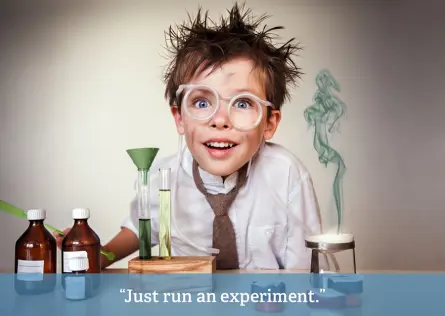A/B Test Ideas to Drive Growth
How many of your A/B tests drive change for your business? Are they gaining you customers, growing your audience, or making your customers’ experiences better? A/B testing is an indispensable framework for collecting audience feedback, acquiring early customers, and scaling your company’s growth.

Shana Rusonis

How many of your A/B tests drive change for your business? Are they gaining you customers, growing your audience, or making your customers’ experiences better?
A/B testing is an indispensable framework for collecting audience feedback, acquiring early customers, and scaling your company’s growth.
We recently co-hosted a webinar with our friends over at KISSmetrics to shed light on how optimization can be baked in to the journey of building your customer base and business. Here are a few of the key takeaways for each stage:
Stage 1: Product Development
At the stage when you’re just starting to build your business, design your products and website, developing an experimental mindset is highly valuable. Build the experimenter mindset and values of data-driven decision making into your business by:
- Building testing hooks into your product. Will you be able to modify payment systems, form fields, or other elements of your company website once you choose to implement A/B testing at scale? Work with your web development team to ensure your website is testing-friendly.
- Constantly referencing customers. Qualitative input is accessible now, and should continue to inform your website changes as you grow. This is where many of your best test ideas will come from in the future – user testing, surveys, and cancellation or return feedback.
- Avoiding creating just one version. Even if you’re wireframing a website flow or product, practice creating variations. Never assume you’ve arrived at the ‘best’ version of your prototype.
Make sure the voice of your customer is heard by everyone at your company:
“It’s the classic Google versus Apple approach to product development. At Google, they have a culture of testing. They allow people to try to test their products in beta. And if the feedback is less than stellar, they’re not afraid to pivot or kill a project… This approach of testing allows you to hedge your bets, introduce more points of failure, and be sure that you have the most optimal solution.”
Stage 2: The Key Conversion Point
As you launch your business online and you grow your traffic, maintain the focus on your final conversion point: what step converts your visitors into customers? If you are a SaaS business, this might be a pricing page. If you have an e-commerce business, this might be a checkout funnel. At this step, remember to:
- Test with an understanding of your audience’s psychological triggers. What information helps your audience purchase? Conversely, what lack of information is preventing them from doing so? Test security badges, disclaimer text, or information about customer service and money-back guarantees.
- Make your conversion pages easy to find. Ensure that your pricing page and checkout pages are easy to navigate to from other areas of your site. Test add buttons to these pages on other high-trafficked pages. This will ensure that you have adequate traffic visiting the page to run your experiments with.
Stage 3: Reorganizing an Expanding Offering
While you develop your online offering, the number of resources, products, and other offerings on your website will continue to increase. But be wary:
“The path of least resistance for companies is to bolt on new features, add another line item, another page in parallel. At this point, things get really hairy—like holiday lights in your garage, they get tangled very quickly. Inevitably, a lot of technical debt amasses.”
At this point, you have opportunities for experimentation to ensure that your visitors are able to accomplish what they intended to do when they arrived at your website. Try:
- Identifying low-converting pages on your website. Look for pages with the highest bounce rate—upwards of 70, 80 percent, or even higher.
- Experimenting with your website navigation. Do you have navigation links or call-to-action buttons leading to your highest-priority pages, like pricing or checkout? You can also expose other supporting areas of your site, like FAQs, a blog, or help center to help your customers find information that they’re looking for before they are ready to convert to customers.
Stage 4: Your First Redesign
A pivotal redesign of your homepage and other web pages is an important juncture to examine key points that you are hoping to strengthen from a conversion rate optimization perspective. To ensure that your new site design outperforms the old one, make sure to:
- Identify the key conversion metrics that you’d like to test before you begin the redesign.
- Test the old website against the redesign before fully launching the new site. It may be the case that even if the new website doesn’t outperform the old one, you still choose to launch the update—most importantly, you want to ensure that you aren’t launching a poorly performing website design.
Stage 5: Segmenting your Audience
Once your audience has grown, you can begin to grouping your customers into meaningful segments. You’ll want to experiment with offerings, messaging, and flows to better match the desired experience of these groups of visitors. To get started with segmentation, try:
- Optimizing landing pages for your SEM traffic to match purchased keywords.
- Refining a major redesign by testing variations targeted at different types of visitors: logged out versus logged in, new versus returning, et cetera.

